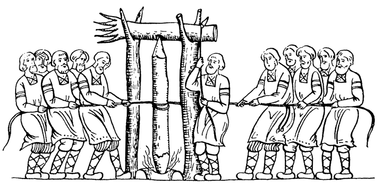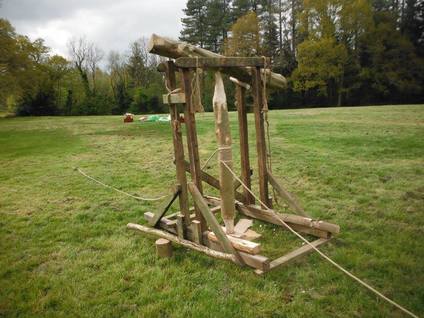|
Please also see the Neid Fire section  An artists impression of the Force Fire method - this is of Russian Origin depicting the Slavic Sacred Live Fire ritual similar to the Celtic Tein'-éigin. image appears in the book "We Are Slavs" by Maria Semyonova. From Wikimedia Commons. An artists impression of the Force Fire method - this is of Russian Origin depicting the Slavic Sacred Live Fire ritual similar to the Celtic Tein'-éigin. image appears in the book "We Are Slavs" by Maria Semyonova. From Wikimedia Commons. Updated Oct 2018. As the end of October is approaching, I thought I would share a piece about Samhain (Samhuinn) and the Samhain fires and in particular Force Fire \ Neid Fire \ Tein'-éigin - which was a traditional way of lighting a new sacred pure fire, at this time (and at Beltaine.) "Samhain is the Gaelic \ Celtic festival seen to mark the end of the harvest season and the beginning of winter or the "darker half" of the year, celebrated from the very beginning of one Celtic day to its end, or in the modern calendar, from sunset on 31 October to sunset on 1 November, this places it about halfway between the Autumn equinox and the Winter solstice" taken from wikipedia. "The 31st is the modern calendar date for Samhuinn. In old calendar times Samhuinn would be around the 11th of November, now Martinmas. Although in reality, it would have been when the moon was dark or other calendar event such as the first frost or when the harvest was in. The date wouldn’t have been set. Banks suggest that the eve of Samhuinn was moonless and in these northern regions, dark, as befitted the “season of innumerable mystic rites” mentioned by Carmichael (which backs up the idea of a dark moon). " from Cailleachs Herbarium. Samhain is also seen as a time to remember and honour the ancestors. "Samhain is believed to have Celtic pagan origins and there is evidence it has been an important date since ancient times. Some Neolithic passage tombs in Ireland are aligned with the sunrise around the time of Samhain. It is mentioned in some of the earliest Irish literature and many important events in Irish mythology happen or begin on Samhain. It was also the time when cattle were brought back down from the summer pastures and when livestock were slaughtered for the winter." taken from wikipedia. Fires were traditionally lit at Samhain (and Beltane) and it is thought that all other fires were extinguished and people lit their hearth fires from the new “pure” fire . There would be much symbology attached to this - to mark the passing into Winter, to burn the old away and welcome the new etc. It is believed that the traditional way of lighting the Samhain\Beltane fires was through a friction fire method known as Force Fire / Neid Fire / Tein'-éigin (as described by 17th,18th and 19th century writers such as Sir James Frazer.) This method was seen to be a sacred and ritual way of lighting fires to produce a new “Pure” fire. It is also written that seasoned Oak was used due to it’s sacredness (Sir James Frazer Golden Bough.)
The auger\spindle would be placed vertically between the cross bar and hearth . The auger needs to be carved as straight as possible and be placed as vertical as possible. A long heavy rope would be tightly wrapped several times around the middle of the auger (it would help to carve a narrower section in the middle so the rope doesn’t move up or down the auger) with an end of the rope on opposite sides and this would be pulled with force and speed in turns by a group at each end of the rope to create friction. The rope would need to be kept tight at all times. The weight of the large auger and heavy cross-bar produce enough downward pressure needed to create the friction, for extra pressure weights could be added to the cross bar. As the auger reduces in height due to friction the cross bar would need to be pulled downwards. Making a full size Force Fire churn requires much effort and time, and operating a Fire Churn involves many people to pull on the ropes to produce an ember and especially with Oak, but ritual is not about speed or efficiency and theatrics does have it's place in ritual! And actually, these devices work beautifully well. According to some folklore nine nines of first begotten son’s were required to pull the rope to “churn” the auger into the hearth log! If you wish to light your fire in a ritual way, I would suggest to try a friction method (e.g. bow drill) and try not using modern lighters\fire lighters (unless necessary) and to try to do it with intention and awareness. See the page Sacred Fire for more information on suggestions of welcoming fire in a sacred and ritual way. Descriptions I’ve read say that this method, produced fierce sparks and “forced” a fire, but I feel this is an over dramatization (Oak doesn’t have the properties to burst into flame in this way!) but there would have been much smoke ( and in reality it would hopefully have created a very large ember which could then be used to light the new pure fire. Once lit ,the pure fire would be kept going until the end of the ritual. Other fires in prominent places may also have been lit from this fire, and people would then light their home hearth fire from the "pure" fire. Some people may question whether Oak was used, but I have proved that Oak does work with the bow drill. The Force Fire apparatus was also used throughout Europe and Russia by the Celts and Slavs. More information can be found on my Fire Churn page here.
Oh this is good... I think this may be the oldest surviving evidence of friction fire. Apparently a 6000 year old wooden Fire Drill was discovered in Canada (Triquet Island , BC) in 2016. Click here for an article in The Vancouver Sun which is showing a photograph of the ancient spindle, but it is lacking information which is surprising as this is quite a find! For me , this is fascinating - the oldest fire drills I am aware of are from China (approx 2500 yo) and Egypt (approx 4000 yo).
There is this paper I have found by Alisha Gauvreau and Dr Duncan McLaren from the Anthropology Department, University of Victoria (B.C) working on the Hakai Ancient Landscapes Archaeology Project - which states that the "Fire Drill" was found in the peat layer which is between 6,726 and 6,674 years old but that's it! I'm surprised there isn't more information on it as it is an amazing find! I'm trying to find archaeological reports for the Triquet Fire Drill but I've not found any yet .... but I'm enquiring with the Hakai Institute - watch this space! It also raises more questions, such as:
The Ancient Triquet Village is one of the oldest settlements discovered in North America (approx 14000 years old) and I found this statement fascinating “It appears we had people sitting in one area making stone tools beside evidence of a fire pit, what we are calling a bean-shaped hearth” (Alisha Gauvreau) .. re-affirming the fire being central to human activity. The other amazing thing about this is that the team based their search on oral stories passed down through generations that this Island had been populated during the Ice Age which alot of people discounted. Link to the article: https://vancouversun.com/news/local-news/heiltsuk-first-nation-village-among-oldest-in-north-america-archeologists |
Archives
January 2024
Categories
All
|

 RSS Feed
RSS Feed